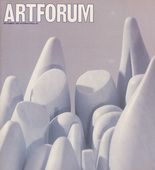
Cat. No. 903
Untitled, no. 58 of 69, from the illustrated book, Album
- State/Variant:
- Only state
- Date:
- 1994
- Illustrated Book:
- Album
- Themes
- Faces & Portaits, Figures, Motherhood & Family, Nature
- Techniques
- Lithography, Other Techniques
- Support:
- Smooth paper, with vellum overlay
- Dimensions:
- vellum overlay: 8 1/4 × 5" (21 × 12.7 cm); page: 8 1/4 × 10 1/2" (21 × 26.6 cm)
- Signature:
- Not signed
- Publisher
- Peter Blum Edition
- Printer
- Albani drukkers
- Edition:
- 850
- Impression:
- Not numbered
- Background:
- This 1994 autobiographical work, titled “Album,” is comprised of old family photographs along with texts by the artist. It is based on a slideshow-format film Bourgeois created in 1983 titled “Partial Recall.” This film was presented in the lobby of The Museum of Modern Art, New York in conjunction with the artist’s 1982–1983 retrospective there. Many of the images in that film appear in “Album,” and much of the book's text comes from the film's voice-over narration by the artist.
“Album” documents aspects of Bourgeois’s early life. The artist, born in 1911, had two siblings: an older sister called Henriette, and a younger brother, Pierre. Until she was six years old, the family lived in Choisy-le-Roi, France in a large home that accommodated the family’s tapestry restoration business, near the River Seine. When World War I broke out, her father enlisted. His wife visited him at various encampments with the young Louise in tow. After the war, the family moved to Antony on the banks of the Bièvre River. They chose their homes with proximity to rivers since the water was important to the process of tapestry restoration. In the early twenties, an English tutor named Sadie Gordon Richmond was hired for the children, but also became the father’s mistress. She stayed in the house for ten years, causing Bourgeois great distress and memories that lasted a lifetime.
At the time the film, "Partial Recall," was made, Bourgeois was also asked to create a page project for Artforum magazine (December 1982) and she based it on some of the same photographs and narration. The Artforum piece, titled “Child Abuse: A Project by Louise Bourgeois” is seen below in Related Works in the Catalogue.
Much later, in 2001, Bourgeois again used some of these photographic images for the fabric illustrated book, “The Trauma of Abandonment,” seen below in Related Work in the Catalogue. - Description:
- Photolithograph
- Pagination:
- Page 61 of 76.
- Housing:
- Cloth-covered hard binding, with brass binding screws. "LB" center cover and "Louise Bourgeois" center spine, embossed in black.
- MoMA Credit Line:
- Gift of the artist
- MoMA Accession Number:
- 196.1997.58
- This Work in Other Collections:
- American Art and Portrait Gallery Library, Smithsonian Institution, Washington, DC
The Baltimore Museum of Art, MD
Brooklyn Museum, NY
Getty Research Institute, Los Angeles
Harvard University, Fine Arts Library, Cambridge, MA
Kunstmuseum Bern, Switzerland
The Museum of Fine Arts, Houston
Walker Arts Center, Minneapolis
Related Works in the Catalogue
Louise Bourgeois,
Album,
New York, Peter Blum Edition, 1994No. 58 of 69
In this photograph, it is about one o’clock
in the afternoon and it is Sunday brunch.
You see him here. He just got up so he is
in one of his negligés, of flannel, white
flannel, there on the left. And he is
teaching his children how to use a gun.
The fact is that his children are not doing
anything. Pierre is there next to me, on
the right. So it’s the two cousins who use
the guns.
Now the whole family is gathered and the
mother is not there. Sure enough, I guess
she’s seeing that the food is being
prepared.
But Sadie is there, in white. You see that
pussycat face on the right? And I am
right next to her. But you see how
everybody is proper and well dressed —
except him.
So if you say, why do I object to my
father’s behavior, it’s that he broke the
rules all the time. All I say is that it is
disturbing. It presents a kind of injustice.






